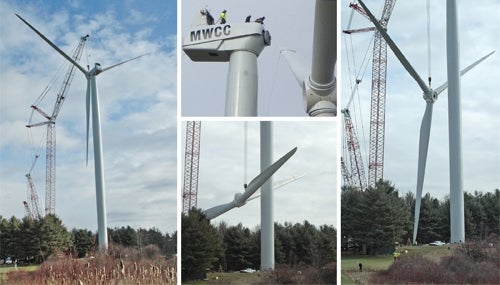Mount Wachusett Community College already has a biomass heating system, a photovoltaic solar power installation and a geothermal heating and cooling device on its Gardner campus.
So for college President Daniel Asquino, the next logical step is to install a wind turbine.
“It’s the one we don’t have yet,” he said.
Not until recently that is. MWCC has completed installation of its first 1.65-megawatt wind turbine and a second one is under construction.
Heading south on Interstate 190 from MWCC is the Bancroft School in Worcester, a kindergarten-through-12th grade private school, which in the last few months has brought a new 462-panel, 106-solar panel array online.
And MWCC and Bancroft aren’t alone. Other schools, including Anna Maria College in Paxton, are considering projects, while still others, including Holy Name High School in Worcester, already have green projects in operation.
The number of renewable energy projects at schools, public or private, demonstrates that education institutions are increasingly at the forefront of the energy-efficiency movement.
While almost all businesses and institutions are looking to save money on energy costs, schools have certain characteristics that can make them ideal spots for energy-efficiency projects.
Energy Hogs
Public schools can typically represent the largest guzzlers of energy for municipalities, so making them more efficient can have a big bang for the buck.
Plus, in an era of belt-tightening because of budget cuts, the more money schools can save in energy, the more money they will have to spend on their true mission: Education.
Schools make up an important clientele for companies that install energy-efficiency products, according to Joseph DeManche, executive vice president at Ameresco Inc. in Framingham.
“It’s an important sector for us,” he said. “It’s generally the first target we see most municipalities go after because for most cities and towns, schools represent their largest conglomeration of any one type of building.”
Schools also have advantages compared to some private customers, DeManche said. Because municipalities know that schools will be in the same building for a long time, they can plan longer-term energy-efficiency projects that yield the most savings.
And the longer a company like Ameresco has to work with a client, usually the larger percentage of savings can be achieved.
The longer time period allows for more sophisticated equipment to be installed, yielding larger savings that can be paid off over a longer period of time.
School officials seem excited about energy projects too, and not just because of the lucrative cost savings they yield.
Mount Wachusett Community College already had an academic program studying natural resources, but this year the school added an associate’s degree in energy management to coincide with the wind turbine installations.
“These (energy-efficiency) projects provide an amazing opportunity for students to get hands-on experience and to see in person exactly what we’re studying,” said the program’s director, David Schmidt.
Unlike taking a field trip where students would just see the projects and then go back to the school, at MWCC the 26 students in the program can speak to the school officials that went through the process of getting an energy project approved, financed and installed.
Project Hurdles
Even if there is a will to become as green as possible, getting the projects done can be another issue. For one, it has to be the right fit, said Asquino.
“You can’t build a wind turbine if you don’t have any wind,” he said.
Other schools are realizing that sometimes such projects take complex legal agreements or reliance on other players.
At Bancroft, for example, a former student’s parent works for a solar installation company in Millbury, Future Solar Systems, and had been advocating for the school to consider a solar project, according to Peter McKone, director of physical plant at the school.
As a nonprofit organization, however, Bancroft could not take advantage of various tax credits and other government incentives to make the project economically viable. So a new limited liability corporation was created that owns the facility and leases the space from the Bancroft School, while in turn the school purchases the electricity at a discounted rate.
Anna Maria College in Paxton has also realized that getting projects approved by local and state officials can be an arduous process.
The college announced plans last year to install a wood-pellet heating system that would have served about 85 percent of the school earlier this year, but state environmental officials have still not yet approved the project.
Officials are also exploring installing a solar-panel project, but the town of Paxton until recently did not have an ordinance governing the parameters of solar panel installations.
Despite the setbacks, the school is moving forward with a $1.5-million efficiency upgrade program that will produce savings across the college’s campus. School officials hope the wood pellet system will be installed next year.

